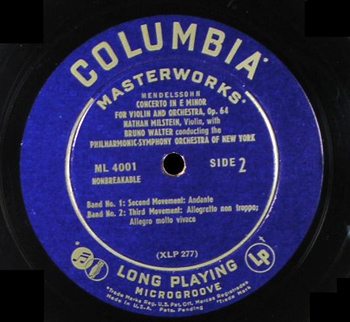
…..Columbia Records started the first mass production of the 33-RPM long player. The new format could contain a maximum of 23 minutes of music per side versus the three minutes that could be squeezed on to a 78 RPM disc.
From Wired
1948: Columbia Records puts the needle down on history’s first successful microgroove plastic, 12-inch, 33-1/3 LPs in New York, sparking a music-industry standard so strong that the digital age has yet to kill it.
Columbia engineer Peter Carl Goldmark set out with his staff in 1939 to evolve the 78-rpm record forward to 33-1/3 rpm, extend playback time to more than 20 minutes per side, and shrink vinyl grooves to an accessible, acceptable millimeter size.
Before that time, music labels, including Columbia and RCA Victor, had failed to launch commercially successful 33-1/3 records to market, for various reasons. Although RCA Victor debuted the first commercially available vinyl long player designed for playback at 33-1/3 in 1931, the Great Depression shelved that ambitious project in 1933.
“When I became general manager of the Victor Division of RCA on July 1, 1933, my first act was to take them off the market,” American Records Corporation president Edward Wallerstein explained. “Most of the records were made from Victorlac, a vinyl compound [and] the pickups available at that time were so heavy they just cut through the material after several plays. The complaints from customers all over the U.S. were so terrific that we were forced to withdraw the LPs.”
Columbia released 33-1/3 10-inchers, but quickly phased them out in 1932, thanks to similarly maddening technical difficulties. The commercial public would not be able to consume and listen to sturdier, lengthier LPs for another 15 years. First, it had to deal with political and economic misery.
The Great Depression and World War II slowed everything down, including Goldmark’s team and its microgroove innovations. But once the war ended, the record business boomed, pulling in more than $10 million in sales by 1945. Cue the applause track.
When Columbia was finally freed from geopolitical conflict and able to resolve the LP’s previous technical difficulties — pickups that were too heavy, grooves that were too wide, playback times that were too short, and audio fidelity that was too crappy — everything changed.
“Goldmark assigned individual researchers to individual problems: cutting-motor and stylus design, pickup design, turntable design, amplifier, radius equalization,” Martin Mayer wrote in a history of the LP published by High Fidelity Magazine in 1958. “The 33-1/3 speed had been established before work began, and it already had become clear that a very narrow groove, something like the .003 inch groove finally adopted, would be necessary to record 22 minutes of music to a side.”
Read more here
If you’re looking for vinyl records, from rarities, new releases, vintage vinyl, imports and more – be sure to visit eil.com to see our vast range of all things vinyl – new stock added daily




Be the first to comment